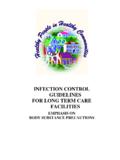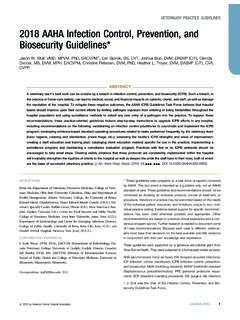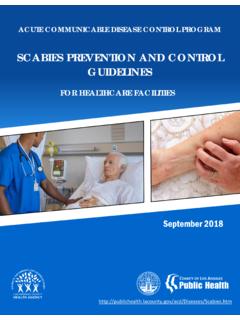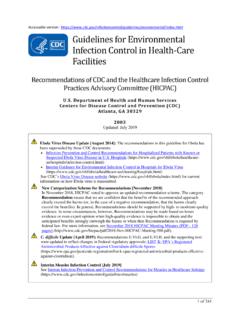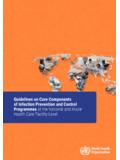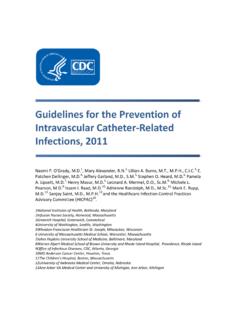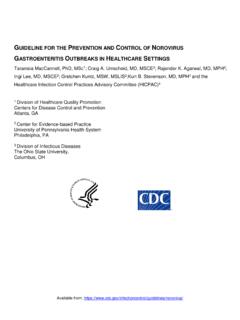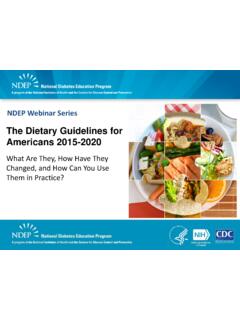Transcription of Guidelines for the identification and management of lead ...
1 Guidelines FOR THE identification AND management OF LEAD EXPOSURE IN PREGNANT AND LACTATING WOMEN Note: This document refers to a blood-lead level of 10 g/dL as the CDC level of concern for adverse health outcomes in children. This terminology is outdated and readers are referred to the ACCLPP recommendations of 2012( ). National Center for Environmental Health Division of Emergency and Environmental Health Services Guidelines FOR THE identification AND management OF LEAD EXPOSURE IN PREGNANT AND LACTATING WOMEN Edited by Adrienne S. Ettinger, ScD, MPH Anne Guthrie Wengrovitz, MPH Centers for Disease control and prevention National Center for Environmental Health/Agency for Toxic Substances and Disease Registry Christopher Portier, PhD Director Healthy Homes and Lead Poisoning prevention Branch Mary Jean Brown, ScD, RN Chief November 2010 Department of Health and Human Services Atlanta, GA This document is dedicated to the memories of Michael W.
2 Shannon, MD, MPH (1953-2009) and Kathryn R. Mahaffey, PhD (1943-2009). Dr. Shannon was a gifted scientist, a respected leader in medicine and public health, and a tireless advocate for prevention of childhood lead poisoning. His contributions to the scientific literature documenting unrec ognized sources of exposure and describing innovative management protocols did much to improve the lives of countless children both in the United States and around the world. Dr. Mahaffey s early work to ensure that blood samples collected during the National Health and Nutrition Examination Surveys increased understanding of lead poisoning and contributed to the identification of lead in gasoline and paint as primary routes of lead exposure in children. She was actively involved in preventing lead exposure in children for over 35 years and provided invaluable assistance with this document. The thoughtful contributions of Drs.
3 Shannon and Mahaffey to the CDC Advisory Committee on Childhood Lead Poisoning prevention will be deeply missed.
4 TABLE OF CONTENTS Preface.. i Executive Summary ..iii Summary of Public Health Actions Based on Maternal and Infant Blood Lead Levels ..vi Members of the Work Group on Lead and Pregnancy .. vii Acknowledgments ..viii Members of the Advisory Committee on Childhood Lead Poisoning prevention .. ix Glossary ..xiii Chapter 1. Introduction..1 Chapter 2 . Adverse Health Effects of Lead Exposure in Pregnancy..5 Chapter 3 . Biokinetics and Biomarkers of Lead in Pregnancy and Lactation .. 27 Chapter 4 . Distribution of BLLs, Risk Factors For and Sources of Lead Exposure in Pregnant and Lactating Women ..35 Chapter 5 . Blood Lead Testing in Pregnancy and Early Infancy..51 Chapter 6 . management of Pregnant and Lactating Women Exposed to Lead.
5 63 Chapter 7 . Nutrition and Lead in Pregnancy and Lactation ..77 Chapter 8 . Chelation of Pregnant Women, Fetuses, and Newborn Infants .. 89 Chapter 9 . Breastfeeding..97 Chapter 10 . Research, Policy, and Health Education Recommendations .. 107 Chapter 11 . Resources and Referral Information.. 113 List of References by Chapter .. 116 APPENDICES I Existing State Legislation Related to Lead and Pregnant Women.. 151 III Commonly Ingested Substances in Pregnancy-related Pica, Reasons for Use, II Charge Questions to the Lead and Pregnancy Work Group .. 155 and Country/Race-Ethnicity of Origin.. 159 IV List of Occupations and Hobbies that Involve Lead Exposure .. 163 V Alternative Cosmetics, Food Additives, and Medicines That Contain Lead .. 167 VI Recommendations for Medical management of Adult Lead Exposure .. 171 VII Medical management Guidelines for Lead-Exposed Adults.
6 183 VIII Pregnancy Risk Assessment Form, NYC DOH.. 201 IX Assessment Interview Form, Minnesota DOH.. 219 X Lead-Based Paint Risk Assessment Form, Minnesota DOH .. 223 XI Primary prevention Information Form, NYC DOH.. 233 XII Child Risk Assessment Form, NYC DOH.. 239 XIII Nutritional Reference Information.. 253 XIV Template for Letter to Construction Employer re: Occupational Exposure .. 263 XV W orkplace Hazard Alert for Lead, Occupational Lead Poisoning prevention Program CA DOH.. 267 LIST OF FIGURES Chapter 1 Figure 1-1. Distribution of Blood Lead Levels in Women of Childbearing Age.. 3 Chapter 3 Figure 3-1. Major Lead Exposure Pathways from Mother to Infant.. 33 Chapter 5 Figure 5-1.
7 New York City Department of Health and Mental Hygiene: Recommended Lead Risk Assessment Questions for Pregnant Women .. 61 Figure 5-2. M innesota Department of Health: Recommended Lead Risk Assessment Questions for Pregnant Women .. 62 LIST OF TABLES Chapter 2 Table 2-1. Summar y of Studies Estimating Association of Prenatal Lead Exposure with Neurodevelopmental Effects .. 13 Chapter 4 Table 4-1. Risk Factors for Lead Exposure in Pregnant and Lactating Women.. 48 Table 4-2. Key R ecommendations to Prevent or Reduce Lead Exposure in Pregnant and Lactating Women.. 49 Chapter 5 Table 5-1. Follow-up of Initial Blood Lead Testing of the Neonate (<1 month of age) .. 58 Table 5-2.
8 Schedule for Follow-up Blood Lead Testing in Infants (<6 months of age) .. 59 Table 5-3. Frequency of Maternal Blood Lead Follow-up Testing During Pregnancy .. 60 Chapter 6 Table 6-1. Recommended Actions by Blood Lead Level in Pregnancy .. 74 Table 6-2. Suggested Factors to Assess and Characterize Pica Behavior .. 75 Chapter 8 Table 8-1. Chelating Agents Used to Treat Lead Poisoning .. 93 Table 8-2. Published Experience with Chelating Agents during Pregnancy in Humans.. 94 Table 8-3. Published Experience with Chelating Agents during Early Postpartum in Humans .. 95 Chapter 9 Table 9-1. Frequency of Maternal Blood Lead Follow-up Testing during Lactation to Assess Risk of Infant Lead Exposure from Maternal Breast Milk .. 103 Table 9-2. Estimated Daily Intake of Lead from Breast Milk at Different Maternal Blood Lead Concentrations.
9 104 Table 9-3. Estima ted Increase in Infant Blood Lead Concentration Associated with Different Maternal Blood Lead Concentrations at 1 Month Postpartum.. 105 PREFACE Lead exposure during pregnancy and breastfeeding can result in lasting adverse health effects independent of lead exposure during other life stages. However, to date there has been limited guidance available for clini cians and the public health community regarding the screening and management of pregnant and lactating women exposed to high levels of lead. Recognizing the need for national recommendations, the Centers for Disease control and prevention and the Advisory Committee on Childhood Lead Poisoning prevention convened a workgroup of recognized experts to review the existing evidence for adverse effects of past and current maternal lead exposure on maternal health and fertility and on the developing fetus, infant, and child in prenatal and postnatal states and to propose evidence-based strategies for intervention.
10 These Guidelines for the identification and management of Lead Exposure in Pregnant and Lactating Women are based on scientific data and practical considerations regarding preventing lead exposure during pregnancy, assessment and blood lead testing during pregnancy, medical and environmental management to reduce fetal exposure, breastfeeding, and follow up of infants and children exposed to lead in utero. The Guidelines also outline a research agenda that will provide crucial information for future efforts to prevent and treat lead exposure during pregnancy and lactation. Further research is needed for a better understand ing of lead s effect on pregnancy outcomes and infant development; lead kinetics across the placenta and in breast milk and their relationship to long-term health effects; genetic susceptibility to damage from lead; as well as the pharmacokinetics, effectiveness, and safety of chelating agents in the pregnant woman.











